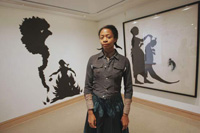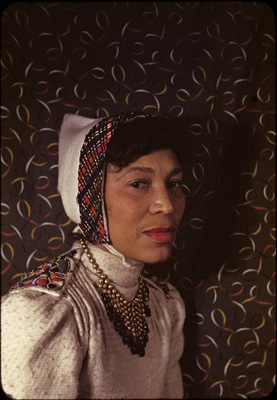return to project
This project is a reaction (positive) to the book "Making Memory Matter" by Lisa Saltzman. Specifically, this project was created in conversation with the projects in Chapter 3, "Negative Images: How a History of Shadows MIght Illuminate the Shadows of History".
 This chapter outlines art by artist attempting to negotiate African-American identity. It also gives a brief history of the silhouette as a form of artistic represenation. Primarily looking at the work of Glenn Ligon and Kara Walker (pictured left), two contemporary African-American artists who play with issues of race, language, gender and sexuality, and the artist who inspired them, a very interesting case is made for playing with the materiality and immateriality of meaning. The artist in this chapter focused on shadow and the interplay of literal black and white on flat, non-projected surfaces. This style of work causes the viewer to fill in the spaces through political, semiotic and literal meanings of their own making that are deeply rooted in the historical narrative of African-Americaness. These works of art purposefully call for a specter be called forward to
This chapter outlines art by artist attempting to negotiate African-American identity. It also gives a brief history of the silhouette as a form of artistic represenation. Primarily looking at the work of Glenn Ligon and Kara Walker (pictured left), two contemporary African-American artists who play with issues of race, language, gender and sexuality, and the artist who inspired them, a very interesting case is made for playing with the materiality and immateriality of meaning. The artist in this chapter focused on shadow and the interplay of literal black and white on flat, non-projected surfaces. This style of work causes the viewer to fill in the spaces through political, semiotic and literal meanings of their own making that are deeply rooted in the historical narrative of African-Americaness. These works of art purposefully call for a specter be called forward to
establish an ethical relation to traumatic history, and, moreover, to its subjects, its victims. Such forms acknowledge, in their refusal of material figuration and in their insistence upon constitutive absence, at once the incommensurablity of representation and, in turn, the ways in which the unrepresentable subjects, historical and human, come to haunt the present while demanding at the same time that they fundamentally defy representation and with that, recognition" (p 53).
Primary Contributions From Saltzman:
- showing how to creatively engage complex histories, specifically in relation to the black/African-American Experience
- Showing the complexities of “History and its ugly iterations in both the culture industry and the cultural imaginary” (p 59), and how this can be both a positive and negative
- relevant, concrete examples for engaging the concept of haunting and specters when approaching issues related to black/African-American/black diasporic experience
The Project
 On "Dat Old Colored Me Feels"
On "Dat Old Colored Me Feels"
In terms or black female academics who I look to from the past, who haunt me, she is probably #1. It seems she has already written the words for much of what I feel during times of frustration especially within the academy and in my research.
The initial thought that came to my mind that I wrote down on a bright pink sticky note in all caps as I read this chapter was "I HAVE TO DO A ZORA PROJECT!" I read this book a short while after seeing a color photograph of Zora Neale Hurston (left) f circulating around the internet and wanted to see how creative work such as the works featured in the chapter could exist in the digital. As I looked at the work from Gunn, which also quoted Zora and the Silhouttes from Walker, I saw a very small project in my head. So much of Zora's work speaks to the experience of being who she is, and what that means. This project uses a black and white cutout of Zora Neale Hurston with the text of her famous essay "How it Feels to be Colored Me" and her voice as she sings "Dat Old Black Gal", to serve as a reminder of her specter/spectre. The words of the text can only as the page is scrolled across her, and even then only partial words and sentences. are visible To see the full text, it must be selected, surrounded by color. Both methods require an action and choice to make Zora's words visible.
Sources:
A compilation of audio files of Zora Neal Hurstons recordings from her work in the WPAin the 1930 can be found at the Florida Memory Project:
http://www.floridamemory.com/audio/hurston.php
"How it Feels to be Colored" can be found in, Hurston, Zora Neale., and Cheryl A. Wall. Folklore, Memoirs, and Other Writings. New York: Library of America, 1995. (accessed via http://solomon.tinyurl.alexanderstreet.com.libproxy.lib.unc.edu/70722)
Saltzman, Lisa. Making Memory Matter : Strategies of Remembrance in Contemporary Art. Chicago: University of Chicago Press, 2006.
Image of Artist Kara Walker from the Contemporary Art & Artists: ARTS 1001 Blog
return to project
 This chapter outlines art by artist attempting to negotiate African-American identity. It also gives a brief history of the silhouette as a form of artistic represenation. Primarily looking at the work of Glenn Ligon and Kara Walker (pictured left), two contemporary African-American artists who play with issues of race, language, gender and sexuality, and the artist who inspired them, a very interesting case is made for playing with the materiality and immateriality of meaning. The artist in this chapter focused on shadow and the interplay of literal black and white on flat, non-projected surfaces. This style of work causes the viewer to fill in the spaces through political, semiotic and literal meanings of their own making that are deeply rooted in the historical narrative of African-Americaness. These works of art purposefully call for a specter be called forward to
This chapter outlines art by artist attempting to negotiate African-American identity. It also gives a brief history of the silhouette as a form of artistic represenation. Primarily looking at the work of Glenn Ligon and Kara Walker (pictured left), two contemporary African-American artists who play with issues of race, language, gender and sexuality, and the artist who inspired them, a very interesting case is made for playing with the materiality and immateriality of meaning. The artist in this chapter focused on shadow and the interplay of literal black and white on flat, non-projected surfaces. This style of work causes the viewer to fill in the spaces through political, semiotic and literal meanings of their own making that are deeply rooted in the historical narrative of African-Americaness. These works of art purposefully call for a specter be called forward to
 On "Dat Old Colored Me Feels"
On "Dat Old Colored Me Feels"